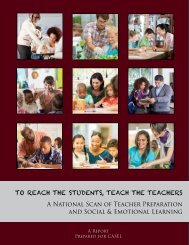Future Ready Learning
7m3sdJ
7m3sdJ
Create successful ePaper yourself
Turn your PDF publications into a flip-book with our unique Google optimized e-Paper software.
Summarizing, Contextualizing, Inferring, Monitoring, and Corroborating<br />
(SCIM-C) framework developed for historical inquiry education. A combined<br />
hardware and software platform is being built to support SCIM-C pedagogy.<br />
Students use a mobile device with AR to augment their “field” experience<br />
at a local historical site. In addition to experiencing the site as it exists, AR<br />
technology allows students to view and experience the site from several social<br />
perspectives and to view its structure and uses across several time periods.<br />
Research focuses on the potential of AR technology in inquiry-based fieldwork<br />
for disciplines in which analysis of change across time is important to promote<br />
understanding of how very small changes across long periods of time may add<br />
up to very large changes.<br />
Across these examples, we see that learning is not contained within screens or<br />
classrooms and that technology can enrich how students engage in the world<br />
around them.<br />
To see additional examples of cyberlearning, visit The Center for Innovative<br />
Research in Cyber<strong>Learning</strong>. 14<br />
Bringing Equity to <strong>Learning</strong> Through Technology<br />
Closing the Digital Use Divide<br />
Traditionally, the digital divide in education referred to schools and communities<br />
in which access to devices and Internet connectivity were either unavailable<br />
or unaffordable. 15 Although there is still much work to be done, great progress<br />
has been made providing connectivity and device access. The modernization of<br />
the federal E-rate program has made billions of dollars available to provide<br />
high-speed wireless access in schools across the country.<br />
E-RATE PROGRAM:<br />
SOURCE OF FUNDING<br />
FOR CONNECTIVITY<br />
The Schools and Libraries<br />
Universal Service Support<br />
Program, commonly known as<br />
the E-rate program, is a source<br />
of federal funding for Internet<br />
connectivity for U.S. schools and<br />
libraries. Created by Congress<br />
in 1996, E-rate provides schools<br />
and libraries with discounted<br />
Internet service on the basis of<br />
need. The program was modernized<br />
in 2014 to ensure there<br />
is sufficient funding available to<br />
meet the need for robust wireless<br />
connectivity within schools<br />
and high-speed connectivity to<br />
schools. For more information<br />
about E-rate, visit the website<br />
of the Federal Communications<br />
Commission (FCC).<br />
OFFICE OF Educational Technology<br />
17



